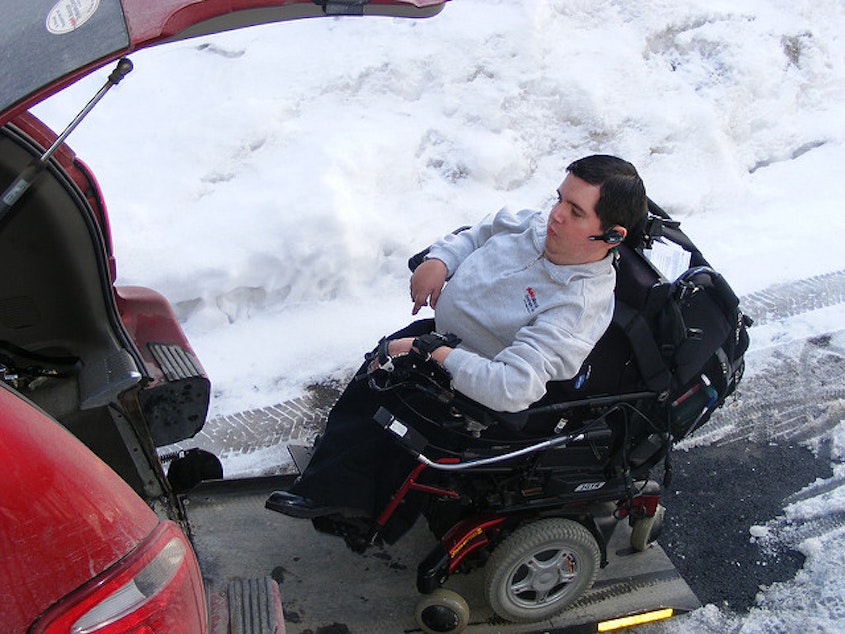For many Seattleites with disabilities, this snow is impassable

You might find the snow charming, or annoying, or no big deal.
But for many Seattle residents, it's dangerous and sometimes impassable. Attorney Conrad Reynoldson is founder of Washington Civil & Disability Advocate; Anna Zivarts is program director of Rooted in Rights. They spoke of the difficulties they and their clients are facing with KUOW's Marcie Sillman.
Conrad Reynoldson and Anna Zivarts on The Record Monday, February 12, 2019
Interview highlights have been lightly edited for clarity
Conrad Reynoldson
Sillman: How are you getting around in this weather?
Sponsored
Reynoldson: I'm a power chair user and admittedly, in the past eight days, I've been able to get out of the house one day.
Sillman: You're trapped in your house?
Reynoldson: Right, and this is the case for countless people with mobility disabilities throughout the city.
Sillman: What's the city's responsibility with the ongoing snow situation?
Reynoldson: Well just as a quick background As far as the Americans With Disabilities Act goes, public entities like the City of Seattle do have an obligation under the ADA to maintain their walkways in accessible condition. But there can be isolated or temporary interruptions.
Sponsored
So weather can sometimes be part of that, but obviously it needs to be prioritized to clear sidewalks, curb cut outs and entrances as quickly as possible.
Sillman: We just heard that it is a city law that business and homeowners are responsible for their sidewalks. So what would you like to see happen with this so that there can be mobility for everybody?
Reynoldson: Just that accessibility is prioritized more and that the plan for dealing with these accessibility issues is clearly communicated. Specifically things like curb cut outs. I would take personal position that snow blocking those is indeed an ADA issue in particular.
Sillman: If you could wave a magic wand and change one thing, what would it be?
Reynoldson: A clearly communicated plan of how accessibility is going to be prioritized and how complaints are dealt with — everything from people getting in and out of their buildings to city and accessible parking. There's a whole range of things that the city should probably be doing.
Sponsored
Anna Zivarts
Sillman: Where in Seattle do you live?
Zivarts: I live in Hillman City, so the south end of town.
Sillman: How have you and your neighbors been getting around, if at all?
Zivarts: I am low vision, I don't drive, and so I generally either walk to the bus or walk to the Link station. With the snow, it's not really possible to walk the longer distance to the Link station. I've been slipping and sliding my way along to the 7 route.
Sponsored
Sillman: That's because of ice. Do you have enough vision to see where it might be particularly treacherous?
Zivarts: I do most of the time in decent light. One thing I've noticed about Seattle compared to other cities is that the sidewalk lighting isn't that great. Streets in my neighborhood are pretty well illuminated, but the sidewalks just aren't.
Sillman: So in terms of of making things accessible for you, what is your priority? What do you put at the top of the list right now?
Zivarts: Like Conrad says, the city has to step up and take a larger role in ensuring that sidewalks and curb ramps are cleared.
You know it's great to assume that homeowners and property owners are going to do that, but you just look at the state of our sidewalks on a good day — you see the cracks and the bumps and how poorly maintained they are. Then, when the snow comes ... I mean on my block I think there was one other household that cleared their sidewalk, and so it just becomes an icy, snowy mess.
Sponsored
I also know that many Seattleites are used to snow that melts in a day or two. This is much more like an East Coast weather pattern where you do have to get out and you have to clear your sidewalk, because if you don't the next day it's going to be even more treacherous and even more icy.
But I would hope that the city can step up and recognize that it should take a bigger role in ensuring that our sidewalks are accessible for everyone. Sweden for example prioritizes sidewalk clearing before they clear roads, and I think it's a choice of what our priorities are as a city.
Produced for the web by Brie Ripley




